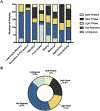Time-of-day as a critical biological variable
- PMID: 34052279
- PMCID: PMC8504485
- DOI: 10.1016/j.neubiorev.2021.05.017
Time-of-day as a critical biological variable
Abstract
Time-of-day is a crucial, yet often overlooked, biological variable in biomedical research. We examined the top 25 most cited papers in several domains of behavioral neuroscience to determine whether time-of-day information was reported. The majority of studies report behavioral testing conducted during the day, which does not coincide with the optimal time to perform the testing from an functional perspective of the animals being tested. The majority of animal models used in biomedical research are nocturnal rodents; thus, testing during the light phase (i.e. animals' rest period) may alter the results and introduce variability across studies. Time-of-day is rarely considered in analyses or reported in publications; the majority of publications fail to include temporal details when describing their experimental methods, and those few that report testing during the dark rarely report whether measures are in place to protect from exposure to extraneous light. We propose that failing to account for time-of-day may compromise replication of findings across behavioral studies and reduce their value when extrapolating results to diurnal humans.
Keywords: Aggression; Attention; Circadian rhythms; Diel; Drug seeking behaviors; Food intake; Learning; Mating behavior; Memory.
Copyright © 2021 Elsevier Ltd. All rights reserved.
Conflict of interest statement
CONFLICTS OF INTEREST
The authors do not have any conflicts of interest to report.
Figures


Similar articles
-
Time of day as a critical variable in biology.BMC Biol. 2022 Jun 15;20(1):142. doi: 10.1186/s12915-022-01333-z. BMC Biol. 2022. PMID: 35705939 Free PMC article. Review.
-
Free-running rhythms and light- and dark-pulse phase response curves for diurnal Octodon degus (Rodentia).Am J Physiol. 1997 Jul;273(1 Pt 2):R278-86. doi: 10.1152/ajpregu.1997.273.1.R278. Am J Physiol. 1997. PMID: 9249561
-
Fos expression within vasopressin-containing neurons in the suprachiasmatic nucleus of diurnal rodents compared to nocturnal rodents.J Biol Rhythms. 1999 Feb;14(1):37-46. doi: 10.1177/074873099129000425. J Biol Rhythms. 1999. PMID: 10036991
-
Light rescues circadian behavior and brain dopamine abnormalities in diurnal rodents exposed to a winter-like photoperiod.Brain Struct Funct. 2018 Jul;223(6):2641-2652. doi: 10.1007/s00429-018-1655-8. Epub 2018 Mar 20. Brain Struct Funct. 2018. PMID: 29560509
-
Social influences on mammalian circadian rhythms: animal and human studies.Biol Rev Camb Philos Soc. 2004 Aug;79(3):533-56. doi: 10.1017/s1464793103006353. Biol Rev Camb Philos Soc. 2004. PMID: 15366762 Review.
Cited by
-
Electroacupuncture Alleviates Neuroinflammation by Inhibiting the HMGB1 Signaling Pathway in Rats with Sepsis-Associated Encephalopathy.Brain Sci. 2022 Dec 17;12(12):1732. doi: 10.3390/brainsci12121732. Brain Sci. 2022. PMID: 36552192 Free PMC article.
-
A modified rehabilitation paradigm bilaterally increased rat extensor digitorum communis muscle size but did not improve forelimb function after stroke.PLoS One. 2024 Apr 11;19(4):e0302008. doi: 10.1371/journal.pone.0302008. eCollection 2024. PLoS One. 2024. PMID: 38603768 Free PMC article.
-
Light Cycle Phase Effects on Behavioral Responses to Stress Exposure in Rats.J Am Assoc Lab Anim Sci. 2025 Jan 1;64(1):64-75. doi: 10.30802/AALAS-JAALAS-24-103. J Am Assoc Lab Anim Sci. 2025. PMID: 40035271 Free PMC article.
-
Circadian neurogenetics and its implications in neurophysiology, behavior, and chronomedicine.Neurosci Biobehav Rev. 2024 Feb;157:105523. doi: 10.1016/j.neubiorev.2023.105523. Epub 2023 Dec 22. Neurosci Biobehav Rev. 2024. PMID: 38142983 Free PMC article. Review.
-
Red Light Sensitivity of Non-image and Image Forming Visual Systems of Laboratory Rodents: Circadian Disruption and Behavioral Detection.J Neurosci. 2025 May 14;45(20):e0157252025. doi: 10.1523/JNEUROSCI.0157-25.2025. J Neurosci. 2025. PMID: 40204436
References
-
- Akhisaroglu M, Ahmed R, Kurtuncu M, Manev H, and Uz T, 2004. Diurnal rhythms in cocaine sensitization and in period1 levels are common across rodent species. Pharmacol. Biochem. Behav 1, 37–42. - PubMed
-
- Amir S, Cain S, Sullivan J, Robinson B, and Stewart J, 1999. In rats, odor-induced fos in the olfactory pathways depends on the phase of the circadian clock. Neurosci. Lett 3, 175–178. - PubMed
-
- Antle MC, and Silver R, 2016. Circadian insights into motivated behavior. Curr. Top. Behav. Neurosci 137–169. - PubMed
-
- Arvanitogiannis A, Sullivan J, and Amir S, 2000. Time acts as a conditioned stimulus to control behavioral sensitization to amphetamine in rats. Neuroscience 1, 1–3. - PubMed
Publication types
MeSH terms
Grants and funding
LinkOut - more resources
Full Text Sources
Other Literature Sources

